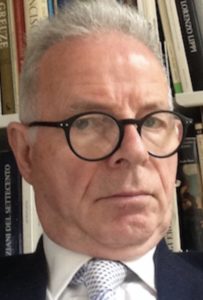 CLOVIS WHITFIELD storico dell’arte, esperto di Caravaggio, Londra
CLOVIS WHITFIELD storico dell’arte, esperto di Caravaggio, Londra
Educated at Cambridge Fine Arts degree 1961, BA and MA Courtauld Institute, London University, Teaching, Bath Academy of Art, Visiting Professor, Indiana University 1967/68, Research at Thos. Agnew & Sons, Associate Director,1969 -76, P&D Colnaghi & Co 1977-81, Walpole Gallery Director 1983-1988, exhibitions, articles in Burlington Magazine, Storia dell’ Arte, etc, monograph on Caravaggio, “Caravaggio’s Eye’ Paul Holberton Press, 2011 (also Italian edition l’Occhio di Caravaggio), numerous articles on Caravaggio in Paragone, Aboutartonline.
I disegni di Caravaggio
3. GIORNATA: SESSIONE POMERIDIANA: Novità ed approfondimenti– venerdì 21 gennaio 2022 ore 15:00-19:00
ABSTRACT
Caravaggio is not known for drawing, but it has become clear from the scientific examination of his pictures that he did use a graphic method in preparation for painting. The medium was a thin mixture of black or dark pigment in a liquid, applied with a fine brush would leave a linear mark like that of a felt-tip pen leaves, but could also be applied with a wider brush. Most of these indications were overpainted by subsequent brushstrokes, but it so happened that works that have suffered abrasion show the preparation much more clearly and demonstrate how much he depended on the accuracy of his observation both for formal analysis and for replication tone and colours.
These lines, which in some of the early works are composed of charcoal, have been revealed by IRR studies, and they indicate the outlines not only of prominent features, but also the limits of areas of light, shade, and colour.
This study casts light on his technique, in which the strokes that have become known as abbozzi and the incisions in the surface of the paint need to be considered in the sequence of his sometimes obsessive observation of his model. The forceful indications of eyebrows, ears etc, were introduced at an early stage, while the well-known incisions for outlines seem to be connected with the position of the model rather than being associated with a pictorial process or invention and design. Apart from the abbozzi, he also used strong dark lines for elements like the mouth, and a broader brush to give the foundation for the rendering of lips. Equally there was a considerable range in the shape and bristles of the brushes that he used.
The lines were not an inventive medium, but part of his meticulous observation, to be followed later with an equally accurate replication of the colours, tones and shadows of what he observed, and one of the reasons why in the next generations he was blamed for ‘merely copying’ what he saw. Some of them are indeed still visible, because he was adept at matching formal limits and realising that the eye interprets the finality of outline. But he was not inclined to present amodal perceptual completion, in other words there is no continuation of profiles, be it people or objects, beyond what was actually visible to his eye.
In conclusion, it is obvious that disegno as it was seen in Caravaggio’s time was associated with the ability to invent a design, the acquired facility of illustrating anatomy, gesture and expression from long practice and memory. The artist relied instead on the extrapolation of a superficial observation of form, and equally it is abundantly clear that he used linear measurements to analyse passage by passage what he had in front of him, and replicate it in a mosaic of observations.
